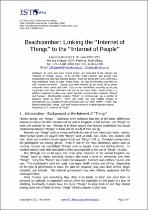JavaScript is disabled for your browser. Some features of this site may not work without it.
- ResearchSpace
- →
- Research Publications/Outputs
- →
- Conference Publications
- →
- View Item
| dc.contributor.author |
Butgereit, L

|
|
| dc.contributor.author |
Coetzee, L

|
|
| dc.date.accessioned | 2011-06-08T11:40:29Z | |
| dc.date.available | 2011-06-08T11:40:29Z | |
| dc.date.issued | 2011-05 | |
| dc.identifier.citation | Butgereit, L and Coetzee, L. 2011. Beachcomber: Linking the “Internet of Things” to the “Internet of People”. IST-Africa 2011 Conference and Exhibition, Gaborone, Botswana, 11-13 May 2011 | en_US |
| dc.identifier.issn | 978-1-905824-24-3 | |
| dc.identifier.uri | http://hdl.handle.net/10204/5050 | |
| dc.description | IST-Africa 2011 Conference and Exhibition, Gaborone, Botswana, 11-13 May 2011 | en_US |
| dc.description.abstract | As more and more “smart things” get connected to the Internet, the “Internet of Things” grows. It is currently quite common that aircraft have transponders and cars have tracking devices. Even the family pet, FIDO, often has a chip embedded. Many of these "smart things" can also be remotely controlled via their Internet connection. Geysers (hot water heaters) can be turned off by power companies when under peak load. Cars can be immobilised remotely by security companies when they determine that the car has been stolen. Beachcomber is a platform designed to allow easy bearer agnostic communication between "things" and humans. Beachcomber enables “things” to communicate via a number of protocols (such as XMPP, HTTP, QR Code, etc) and enables humans to communicate via a number of other protocols (such as Email, XMPP, Twitter, etc). Beachcomber links “things” with their human owners in a bearer agnostic manner. | en_US |
| dc.language.iso | en | en_US |
| dc.relation.ispartofseries | Workflow request;6622 | |
| dc.subject | Internet of Things (IOT) | en_US |
| dc.subject | Internet of People | en_US |
| dc.subject | Beachcomber | en_US |
| dc.title | Beachcomber: Linking the “Internet of Things” to the “Internet of People” | en_US |
| dc.type | Conference Presentation | en_US |
| dc.identifier.apacitation | Butgereit, L., & Coetzee, L. (2011). Beachcomber: Linking the “Internet of Things” to the “Internet of People”. http://hdl.handle.net/10204/5050 | en_ZA |
| dc.identifier.chicagocitation | Butgereit, L, and L Coetzee. "Beachcomber: Linking the “Internet of Things” to the “Internet of People”." (2011): http://hdl.handle.net/10204/5050 | en_ZA |
| dc.identifier.vancouvercitation | Butgereit L, Coetzee L, Beachcomber: Linking the “Internet of Things” to the “Internet of People”; 2011. http://hdl.handle.net/10204/5050 . | en_ZA |
| dc.identifier.ris | TY - Conference Presentation AU - Butgereit, L AU - Coetzee, L AB - As more and more “smart things” get connected to the Internet, the “Internet of Things” grows. It is currently quite common that aircraft have transponders and cars have tracking devices. Even the family pet, FIDO, often has a chip embedded. Many of these "smart things" can also be remotely controlled via their Internet connection. Geysers (hot water heaters) can be turned off by power companies when under peak load. Cars can be immobilised remotely by security companies when they determine that the car has been stolen. Beachcomber is a platform designed to allow easy bearer agnostic communication between "things" and humans. Beachcomber enables “things” to communicate via a number of protocols (such as XMPP, HTTP, QR Code, etc) and enables humans to communicate via a number of other protocols (such as Email, XMPP, Twitter, etc). Beachcomber links “things” with their human owners in a bearer agnostic manner. DA - 2011-05 DB - ResearchSpace DP - CSIR KW - Internet of Things (IOT) KW - Internet of People KW - Beachcomber LK - https://researchspace.csir.co.za PY - 2011 SM - 978-1-905824-24-3 T1 - Beachcomber: Linking the “Internet of Things” to the “Internet of People” TI - Beachcomber: Linking the “Internet of Things” to the “Internet of People” UR - http://hdl.handle.net/10204/5050 ER - | en_ZA |






